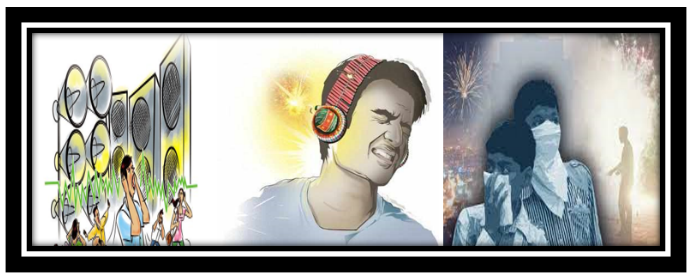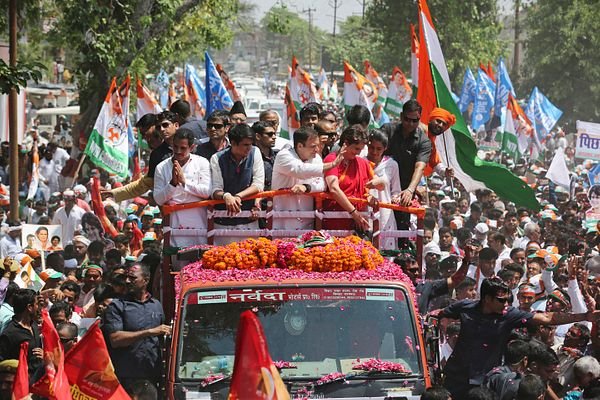Context
The article emphasizes the need to address the noise crisis associated with firecrackers during festivals.
About
- Noise Pollution is generally defined as regular exposure to elevated sound levels that may lead to adverse effects in humans or other living organisms.
- According to the World Health Organization, noise above 65 decibels (dB) is defined as noise pollution.
- To be precise, noise becomes harmful when it exceeds 75 decibels (dB) and is painful above 120 dB.
Noise Pollution’s Impact on Human Health
| Impact | Description |
| Hypertension | Prolonged exposure to elevated noise levels can lead to hypertension (high blood pressure), increasing the risk of cardiovascular diseases. More than 75 dB in offices is associated with hypertension. |
| Cardiovascular Dysfunction | Elevated blood pressure due to noise pollution, especially at night, can contribute to various cardiovascular diseases, including heart attacks and strokes |
| Dementia | While not a direct cause, noise pollution can exacerbate or contribute to the onset of dementia. Chronic noise exposure increases stress levels, associated with dementia risk |
| Hearing Loss | Noise pollution from various sources, including loud music and work place noise, can directly cause hearing loss. Extended exposure to high-decibel noise can damage delicate ear structures. |
| Psychological Dysfunctions and Noise Annoyance | Noise annoyance, an emotional reaction to continuous noise exposure, can lead to stress, irritability, anxiety, and other psychological ysfunctions. |
Impact on the Ecosystem
| Impact on Wildlife |
|
| Impact on Animal health |
|
| Marine Life |
|
| Loss of Biodiversity |
|
Arguments by Supreme Court
- Bursting crackers is not a fundamental right and an essential practice during religious festivals like Diwali.
- Article 25 (right to religion) is subject to Article 21 (right to life).
- If a particular religious practice is threatening the health and lives of people, such practice is not entitled to protection under Article 25.
- Our endeavour is to strive at balancing of two rights, namely, right of the petitioners under Article 21 and right of the manufacturers and traders under Article 19(1)(g) of the Constitution.
Regulations regarding Noise Pollution
- The Noise Pollution (Regulation and Control) Rules 2000 under the Environment Protection Act 1986 mandate that firecrackers cannot be used in ‘silence zones’, and anywhere after 10 PM.
- Section 2 (a) of the Air (Prevention and Control of Pollution) Act, 1981 considers noise as ‘air pollutant’.
- From 6 AM to 10 PM, firecracker noise cannot exceed 75 dB.
- The thresholds in commercial and residential areas are 65 dB and 55 dB, respectively.
- Central Pollution Control Board (CPCB) has listed fines for the violation of noise pollution norms, including the use of loudspeakers or public addresses that can result in a fine of Rs 10,000.
- Exemption: The state government can provide exemption during any cultural or religious festive occasion of a limited duration not exceeding 15 days in all during a calendar year.
Issues with noise pollution regulation
- Demarcation of zones: Different loudness zones are also seldom publicly demarcated. Some places are both residential and commercial.
- Ambiguity of rules: The rules are unclear about the sanctions to be meted out to offenders.
Need for effective management
- Limit firecracker production to curb noise and pollution.
- CSIR introduced eco-friendly “green” crackers in 2018, mandated by authorities.
- Cities should share noise data and set targets.
- Urban Planning: Cities must incorporate noise mitigation measures into their urban planning.
- This includes sound barriers along highways, green buffer zones around industrial areas, and the promotion of quieter transport options.
- Public Awareness: Raising awareness about the harmful effects of noise pollution is essential.
- Educational campaigns can inform the public about the risks and encourage responsible behaviour, such as reducing noise levels in residential areas.
Conclusion
- Although noise pollution may seem harmless, it, in fact, has far-reaching consequences. The adverse effects on the health of the environment are quite severe.
- Not only is the local wildlife affected by pollution but humans also face a number of problems due to it





